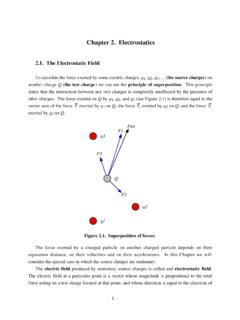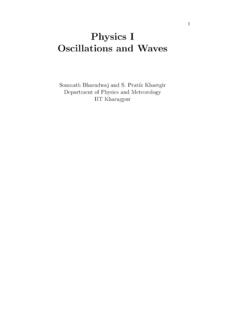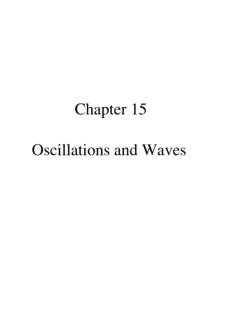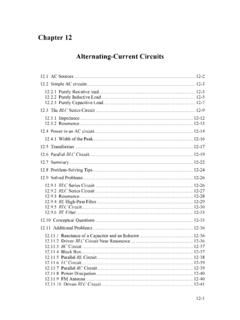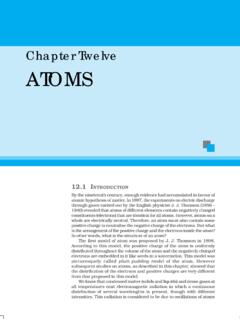Transcription of Physics 235 Chapter 12 - University of Rochester
1 Physics 235 Chapter 12 - 1 - Chapter 12 Coupled oscillations Many important Physics systems involved coupled oscillators. Coupled oscillators are oscillators connected in such a way that energy can be transferred between them. The motion of coupled oscillators can be complex, and does not have to be periodic. However, when the oscillators carry out complex motion, we can find a coordinate frame in which each oscillator oscillates with a very well defined frequency. A solid is a good example of a system that can be described in terms of coupled oscillations . The atoms oscillate around their equilibrium positions, and the interaction between the atoms is responsible for the coupling. To start our study of coupled oscillations , we will assume that the forces involved are spring-like forces (the magnitude of the force is proportional to the magnitude of the displacement from equilibrium).
2 Two Coupled Harmonic Oscillators Consider a system of two objects of mass M. The two objects are attached to two springs with spring constants (see Figure 1). The interaction force between the masses is represented by a third spring with spring constant 12, which connects the two masses. Figure 1. Two coupled harmonic oscillators. We will assume that when the masses are in their equilibrium position, the springs are also in their equilibrium positions. The force on the left mass is equal to F1=!"x1+"12x2!x1()=!"+"12()x1+"12x2=M!!x 1 The force on the right mass is equal to F2=!"x2+"12x1!x2()=!"+"12()x2+"12x1=M!!x 2 The equations of motion are thus Physics 235 Chapter 12 - 2 - M!!x1+!+!12()x1"!12x2=0 M!
3 !x2+!+!12()x2"!12x1=0 Since it is reasonable to assume that the resulting motion has an oscillatory behavior, we consider following trial functions: x1t()=B1ei!t x2t()=B2ei!t Substituting these trial functions into the equations of motion we obtain the following conditions: !+!12"M#2()B1"!12B2=0 !"12B1+"+"12!M#2()B2=0 These equations only will have a non-trivial solution if !+!12"M#2"!12"!12!+!12"M#2=0 Note: the trivial solution is B1 = B2 = 0. The requirement for a non-trivial solution requires that the angular frequency of the system is equal to one of the following two characteristic frequencies (the so called eigen frequencies): !1= "+2"12M !2= "M For each of these frequencies, we can now determine the amplitudes B1 and B2.
4 Let us first consider the eigen frequency 1. For this frequency we obtain the following relations between B1 and B2: !+!12"!+2!12()()B1"!12B2="!12B1"!12B2="! 12B1+B2()=0 or B1 = -B2. For the eigen frequency 2 we obtain the following relations between B1 and B2: Physics 235 Chapter 12 - 3 - !+!12"!()B1"!12B2=!12B1"!12B2=!12B1"B2() =0 or B1 = B2. The most general solution of the coupled harmonic oscillator problem is thus x1t()=B1+e+i!1t+B1"e"i!1t+B2+e+i!2t+B2"e "i!2t x2t()=!B1+e+i"1t!B1!e!i"1t+B2+e+i"2t+B2! e!i"2t Another approach that can be used to solve the coupled harmonic oscillator problem is to carry out a coordinate transformation that decouples the coupled equations. Consider the two equations of motion. If we add them together we get M!
5 !x1+!!x2()+!x1+x2()=0 If we subtract from each other we get M!!x1!!!x2()+"+2"12()x1!x2()=0 Based on these two equations it is clear that in order to decouple the equations of motion we need to introduce the following variables !1=x1"x2 !2=x1+x2 The solutions to the decoupled equations of motion are !1t()=C1+ei"1t+C1#e#i"1t !2t()=C2+ei"2t+C2#e#i"2t where the frequencies are the characteristic frequencies discussed before. Once we have these solutions we can determine the positions of the masses as function of time: x1t()=12!2t()+!1t()() x2t()=12!2t()"!1t()() Physics 235 Chapter 12 - 4 - We note that the solution 1 corresponds to an asymmetric motion of the masses, while the solution 2 corresponds to an asymmetric motion of the masses (see Figure 2).
6 Since higher frequencies correspond to higher energies, the asymmetric mode (out of phase) has a higher energy. Figure 2. Normal modes of oscillation. Weak Coupling Coupled oscillations , involving a weak coupling, are important to describe many physical systems. For example, in many solids, the force that tie the atoms to their equilibrium positions are very much stronger than the inter-atomic coupling forces. In the example we discussed in the pervious section, the weak coupling limit requires that 12 << . In this approximation we can show (see text book for details) that our solutions have a high-frequency component that oscillates inside a slowly varying component (see Figure 3). The solutions are thus sinusoidal functions with a slowly varying amplitude.
7 Figure 3. Examples of solution in the weak-coupling limit. Physics 235 Chapter 12 - 5 - Example: Problem Reconsider the problem of two coupled oscillators discussion in Section in the event that the three springs all have different force constants. Find the two characteristic frequencies, and compare the magnitudes with the natural frequencies of the two oscillators in the absence of coupling. The equations of motion are M!!x1+!1+!12()x1"!12x2=0M!!x2+!2+!12()x2 "!12x1=0#$%% (1) We attempt a solution of the form x1t()=B1ei!tx2t()=B2ei!t"#$$ (2) Substitution of (2) into (1) yields !1+!12"M#2()B1"!12B2=0"!12B1+!2+!12"M#2( )B2=0$%&&& (3) In order for a non-trivial solution to exist, the determinant of coefficients of B1 and B2 must vanish.
8 This yields !1+!12"M#2()$%&'!2+!12"M#2()$%&'=!122 (4) from which we obtain !2="1+"2+2"122M 12M"1#"2()2+4"122 (5) This result reduces to !2="+"12 "12()M for the case !1=!2=! (compare Eq. ( )]. If m2 were held fixed, the frequency of oscillation of m1 would be !012=1M"1+"12() (6) while in the reverse case, m2would oscillate with the frequency Physics 235 Chapter 12 - 6 - !022=1M"2+"12() (7) Comparing (6) and (7) with the two frequencies, !+and!", given by (5), we find !+2=12M"1+"2+2"12+"1#"2()2+4"122$%&'() >12M!1+!2+2!12+!1"!2()#$%&=1M!1+!12()='0 12 (8) so that !+>!01 (9) Similarly, !"2=12M#1+#2+2#12"#1"#2()2+4#122$%&'() <12M!1+!2+2!12"!1"!2()#$%&=1M!2+!12()='022 (10) so that !"<!02 (11) If !1>!2, then the ordering of the frequencies is !)
9 +>!01>!02>!" (12) Example: Problem Two identical harmonic oscillators (with masses M and natural frequencies w0) are coupled such that by adding to the system a mass m, common to both oscillators, the equations of motion become !!x1+mM!!x2+!02x1=0!!x2+mM!!x1+!02x2=0"# $$$$ Solve this pair of coupled equations, and obtain the frequencies of the normal modes of the system. Physics 235 Chapter 12 - 7 - The equations of motion are !!x1+mM!!x2+!02x1=0!!x2+mM!!x1+!02x2=0"# $$$$ (1) We try solutions of the form x1t()=B1ei!t;x2t()=B2ei!t (2) We require a non-trivial solution ( , the determinant of the coefficients of B1 and B2 equal to zero), and obtain !02"!2()2"!4mM#$%&'(2=0 (3) so that !02"!2= !2mM (4) and then !)
10 2=!021 mM (5) Therefore, the frequencies of the normal modes are !1=!021+mM!2=!021"mM (6) where !1 corresponds to the symmetric mode and !2 to the anti-symmetric mode. By inspection, one can see that the normal coordinates for this problem are the same as those for the example of Section Another approach to find the normal coordinates is to try to find ways to add the two equations of motion in such a way that we get an uncoupled differential equation. Consider what happens when we multiply the first equation of motion by and add it to the second equation of motion: Physics 235 Chapter 12 - 8 - !!!x1+mM!!x2+"02x1#$%&'(+!!x2+mM!!x1+"02 x2#$%&'(=!+mM#$%&'(!!x1+1+!mM#$%&'(!!x2+ "02!x1+x2()==d2dt2!+mM#$%&'(x1+1+!mM#$%& '(x2#$%&'(+"02!)))))))


